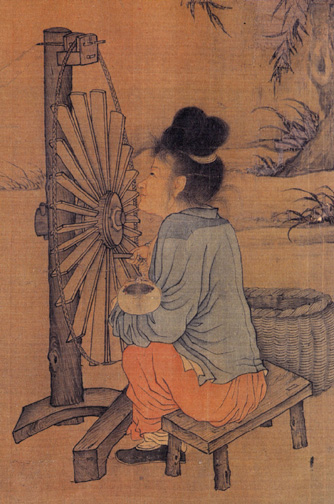This week was a lot of fun when we were learning about textiles! In class on Tuesday, we were assigned to watch videos on the process of making yarn – a very detailed process for sure! There are many different steps to creating yarn (or silk) which can then be used to weave and create the material and clothing that we know and use everyday. In class, we attempted drop spindle spinning, the oldest way known to make yarn. Although challenging at first, it does get easier with practice and in the end was very fun! There were many issues when starting the drop spin, because you have to make sure you are spinning the correct way, and making sure to draft the fibers so they can spin correctly. It is a very tedious process which you need to make sure you are doing correctly! After attempting the drop spin, we then practiced hand carding fleece to use for spinning. In the yarn making process, hand carding comes before drop spinning, because this is the way to prepare the fibers after they have been sheered off a sheep. Hand carding definitely requires some hand strength and muscles in order to unknot and flatten the fleece in order for it to be long enough to use to spin to make yarn. Learning about these processes and the patience, time and strength it takes to create yarn helps provide insight into what many crafters during ancient China and even today had to go through. Many women used this process to make clothing which took an intricate amount of time, but was not seen as important as the role of men. This is upsetting because this process is so tedious and takes an expert to really create something beautiful and worthy of wearing, yet these people did not receive the credit they deserved. In class it was mentioned that children would learn and master the drop spindle craft at the early age of four. Thinking about what I have accomplished at such an early age is really not much of a comparison to what these children could do at such a young age!
I really enjoyed the change in this class from more of a group lecture style learning to hands on learning! It helped me stay focused and active in class and also gain a better insight into the work people put in to create such beautiful craftmanship that is still valuable today.

In Thursday’s class, we talked more about the value of textiles and how they were used as a form of money and a way to pay taxes. It was really interesting to read about how people could cheat the system by making their materials seem heavier than they actually are or changing the weaving so that it appears to be up to standards which the emperor has put in place. It is very similar to how people today try to cheat out of paying their taxes or cheat when it comes to government requirements. I also enjoyed reading about the different types of weaving styles and how clothing was classified. Many people knew about the particular way to dye clothing and what material was more expensive based on the weaving style or embroidery, as well as the color. It is fascinating to learn so much about a culture just based on their clothing and fashion choices.
Xue, Meng Melanie. Cotton Textile Production in Medieval China Unravelled the Patriarchy, Aeon, June 27, 2018.
Sheng, Angela. “Determining the Value of Textiles in the Tang Dynasty: In Memory of Professor Denis Twitchett (1925-2006)”. Journal of the Royal Asiatic Society, Third Series, 23, no. 2 (2013): 175-95.
https://docs.google.com/presentation/d/1UfekfL-hFOwB6EFmY61bCOfpLCVjJvSYTt6Kj1Vl5IU/edit